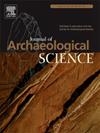A method for constructing demographic profiles of Ovis orientalis/O. aries using Logarithm Size Index scaling
IF 2.5
1区 地球科学
Q1 ANTHROPOLOGY
引用次数: 0
Abstract
This paper presents a new method for constructing demographic profiles of archaeological sheep skeletal assemblages drawing on a method developed for Sus scrofa (Zeder and Lemoine, 2020a) and, most recently, for goats (Zeder, 2024a). This method normalizes metric data using the Logarithm Size Index (LSI) scaling technique. LSI values of post-crania metric data of modern wild sheep from Iran and Iraq are shown to reflect strong sexual dimorphism in body size which is evident in animals over one year of age. After adjustments to account for the impacts of region and age on body size, along with differentials in the scaling of different elements, the mid-point of the range of LSI values is shown to be a reliable and accurate way of distinguishing between the elements of females and males that can then be used to construct sex-specific age profiles. This method is applied to metric data from thirteen archaeological sheep skeletal assemblages from the Zagros Mountains of Iran and Iraq spanning the period from the Middle Paleolithic to the Ceramic Neolithic. The resulting sex-specific demographic profiles indicate that during pre-ceramic periods hunters practiced varied prey strategies that targeted different segments of wild sheep populations. A clear signal of herding is detectable in Ceramic Neolithic assemblages despite limitations in the recovery of unfused elements. The paper concludes by offering recommendations, and caveats, to the use of this method for building sex-specific demographic profiles of ancient sheep assemblages.
一种建立东方羊的人口统计资料的方法。使用对数大小索引缩放
本文提出了一种新的方法来构建考古绵羊骨骼组合的人口统计剖面,该方法借鉴了为Sus scrofa (Zeder and Lemoine, 2020a)开发的方法,以及最近为山羊(Zeder, 2024a)开发的方法。该方法使用对数大小指数(LSI)缩放技术规范化度量数据。来自伊朗和伊拉克的现代野生绵羊颅骨后测量数据的LSI值显示,在一岁以上的动物中,身体大小明显存在强烈的性别二态性。在考虑了地域和年龄对体型的影响以及不同元素比例的差异后,LSI值范围的中点被证明是区分女性和男性元素的可靠和准确的方法,然后可以用来构建性别特定的年龄剖面。该方法应用于从旧石器时代中期到新石器时代陶瓷时期的伊朗和伊拉克扎格罗斯山脉的13个考古羊骨骼组合的度量数据。结果表明,在前陶瓷时期,猎人针对不同的野生羊种群采用了不同的猎物策略。在新石器时代的陶瓷组合中,放牧的明显信号是可检测到的,尽管在恢复未融合元素方面存在局限性。论文最后对使用这种方法建立古代绵羊群体的性别特异性人口统计资料提出了建议和警告。
本文章由计算机程序翻译,如有差异,请以英文原文为准。
求助全文
约1分钟内获得全文
求助全文
来源期刊

Journal of Archaeological Science
地学-地球科学综合
CiteScore
6.10
自引率
7.10%
发文量
112
审稿时长
49 days
期刊介绍:
The Journal of Archaeological Science is aimed at archaeologists and scientists with particular interests in advancing the development and application of scientific techniques and methodologies to all areas of archaeology. This established monthly journal publishes focus articles, original research papers and major review articles, of wide archaeological significance. The journal provides an international forum for archaeologists and scientists from widely different scientific backgrounds who share a common interest in developing and applying scientific methods to inform major debates through improving the quality and reliability of scientific information derived from archaeological research.
 求助内容:
求助内容: 应助结果提醒方式:
应助结果提醒方式:


